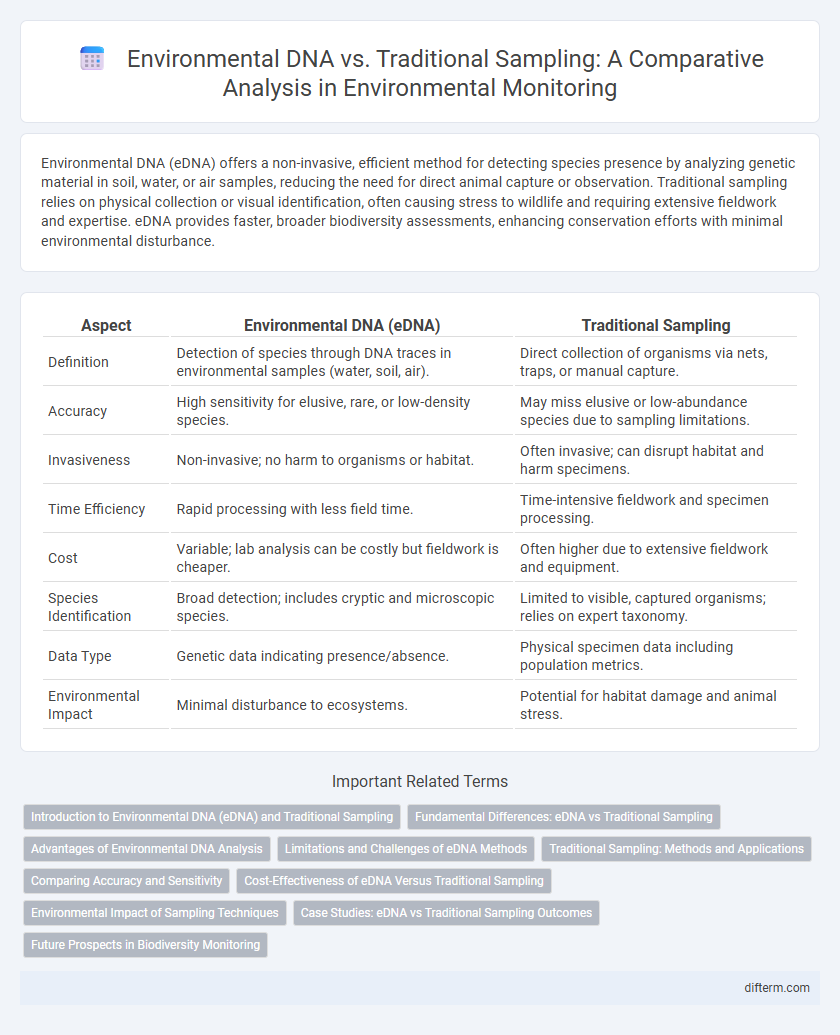Environmental DNA (eDNA) offers a non-invasive, efficient method for detecting species presence by analyzing genetic material in soil, water, or air samples, reducing the need for direct animal capture or observation. Traditional sampling relies on physical collection or visual identification, often causing stress to wildlife and requiring extensive fieldwork and expertise. eDNA provides faster, broader biodiversity assessments, enhancing conservation efforts with minimal environmental disturbance.
Table of Comparison
| Aspect | Environmental DNA (eDNA) | Traditional Sampling |
|---|---|---|
| Definition | Detection of species through DNA traces in environmental samples (water, soil, air). | Direct collection of organisms via nets, traps, or manual capture. |
| Accuracy | High sensitivity for elusive, rare, or low-density species. | May miss elusive or low-abundance species due to sampling limitations. |
| Invasiveness | Non-invasive; no harm to organisms or habitat. | Often invasive; can disrupt habitat and harm specimens. |
| Time Efficiency | Rapid processing with less field time. | Time-intensive fieldwork and specimen processing. |
| Cost | Variable; lab analysis can be costly but fieldwork is cheaper. | Often higher due to extensive fieldwork and equipment. |
| Species Identification | Broad detection; includes cryptic and microscopic species. | Limited to visible, captured organisms; relies on expert taxonomy. |
| Data Type | Genetic data indicating presence/absence. | Physical specimen data including population metrics. |
| Environmental Impact | Minimal disturbance to ecosystems. | Potential for habitat damage and animal stress. |
Introduction to Environmental DNA (eDNA) and Traditional Sampling
Environmental DNA (eDNA) is a modern technique that detects genetic material shed by organisms into water, soil, or air, enabling the identification of species without direct observation or capture. Traditional sampling relies on physical collection methods such as netting, trapping, or visual surveys to assess biodiversity and ecosystem health. eDNA offers higher sensitivity and non-invasive monitoring compared to labor-intensive and potentially disruptive traditional methods.
Fundamental Differences: eDNA vs Traditional Sampling
Environmental DNA (eDNA) sampling captures genetic material shed by organisms into water, soil, or air, enabling detection without direct observation or capture. Traditional sampling relies on physically collecting specimens through nets, traps, or visual surveys, often requiring extensive labor and expertise. eDNA offers a non-invasive, highly sensitive approach that can detect elusive or low-density species, contrasting with the more invasive and potentially disruptive nature of traditional methods.
Advantages of Environmental DNA Analysis
Environmental DNA (eDNA) analysis offers significant advantages over traditional sampling by enabling non-invasive detection of species presence, reducing the need for physical capture or habitat disturbance. It provides higher sensitivity in identifying rare or elusive organisms, allowing for early detection of invasive species and improved biodiversity monitoring. Furthermore, eDNA methods can cover larger spatial scales with less effort and cost, enhancing efficiency in ecological studies and conservation efforts.
Limitations and Challenges of eDNA Methods
Environmental DNA (eDNA) methods face limitations such as degradation of DNA in aquatic environments, leading to potential false negatives and reduced detection sensitivity. Traditional sampling allows for direct observation and specimen verification but is often labor-intensive and may miss cryptic or low-abundance species. Challenges with eDNA also include contamination risks, difficulty in quantifying biomass, and limited taxonomic resolution for closely related species.
Traditional Sampling: Methods and Applications
Traditional sampling methods in environmental monitoring include techniques such as netting, trapping, electrofishing, and direct observation, which are widely used for assessing biodiversity and population dynamics. These approaches provide tangible specimens for morphological identification and allow for detailed ecological studies, including behavioral and physiological assessments. Despite being labor-intensive and sometimes invasive, traditional sampling remains essential for verifying species presence and understanding habitat conditions in freshwater, marine, and terrestrial ecosystems.
Comparing Accuracy and Sensitivity
Environmental DNA (eDNA) sampling offers higher sensitivity by detecting trace genetic material from organisms, enabling identification of rare or elusive species that traditional sampling methods may miss. Traditional sampling relies on physical collection of specimens, which can be limited by species behavior, habitat accessibility, and sampling effort, often resulting in lower detection rates. Studies show eDNA consistently provides more accurate biodiversity assessments, especially in aquatic environments, by capturing a comprehensive snapshot of species presence without the biases inherent in conventional techniques.
Cost-Effectiveness of eDNA Versus Traditional Sampling
Environmental DNA (eDNA) sampling offers a more cost-effective approach compared to traditional methods by reducing labor, time, and equipment expenses. Traditional sampling often requires extensive fieldwork and species identification expertise, which increases overall project costs. Advances in eDNA technology allow for rapid, large-scale biodiversity assessments at a fraction of the price, making it an economically viable option for long-term environmental monitoring.
Environmental Impact of Sampling Techniques
Environmental DNA (eDNA) sampling significantly reduces habitat disturbance compared to traditional methods like netting or electrofishing, which can harm aquatic organisms and disrupt ecosystems. eDNA techniques enable non-invasive monitoring of species by analyzing genetic material shed into water, soil, or air, minimizing physical sample collection and preserving biodiversity. This method also decreases the carbon footprint associated with fieldwork by requiring less equipment and fewer personnel, enhancing sustainable environmental monitoring practices.
Case Studies: eDNA vs Traditional Sampling Outcomes
Case studies comparing environmental DNA (eDNA) and traditional sampling reveal eDNA's superior sensitivity in detecting rare and elusive aquatic species, often identifying more biodiversity than netting or visual surveys. In one study, eDNA detected invasive species earlier than traditional methods, enabling faster management actions and reducing ecological impacts. These outcomes demonstrate eDNA's efficiency in monitoring ecosystems with less disturbance and greater accuracy.
Future Prospects in Biodiversity Monitoring
Environmental DNA (eDNA) offers a transformative approach to biodiversity monitoring by enabling non-invasive, highly sensitive detection of species across diverse ecosystems, surpassing the limitations of traditional sampling methods such as netting or visual surveys. Future prospects of eDNA include real-time monitoring through automated sampling devices and integration with AI-driven data analysis to rapidly assess ecosystem health and detect invasive species at early stages. Scaling eDNA technology globally promises comprehensive biodiversity assessments, aiding conservation efforts and informing policy decisions with unprecedented accuracy and efficiency.
environmental DNA vs traditional sampling Infographic

 difterm.com
difterm.com